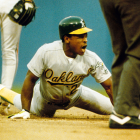While the postseason is in full swing, MLB and the MLB Players Association are hard at work behind the scenes negotiating the new collective bargaining agreement. The current CBA expires Dec. 1. Commissioner Rob Manfred recently said he hopes the two sides can announce the new deal soon after the end of the World Series.
According to ESPN's Buster Olney, MLB is pushing for an international draft during bargaining with the players union. This is not surprising. MLB has wanted an international draft for years -- more than anything, this is a way to lower costs for the owners -- but the MLBPA has resisted thus far.
Here are some more details, from Olney:
Under the terms of MLB's initial concept, the new international draft system would start in March of 2018, with a 10-round draft held over two days. As the new structure evolved, with terms grandfathered into the process, the minimum age for draft-eligible players would be 18 years old by 2021.
As part of baseball's proposal, MLB would operate facilities in the Dominican Republic, where international draft prospects would be invited to live to develop their skills and education before becoming eligible. This would also give MLB much greater control over a process which has often been viewed by baseball executives as a wild, wild West of player procurement.
This represents a significant change to the international system. At the moment, teams are given bonus pools to spend on international players each year, with the worst teams getting the most money. The international signing period opens every July 2 and players must be at least 16 to sign. It's a free-agent system. Any team can sign any player.
In the past few years several teams have made a mockery of the system by exceeding their bonus pool. The Yankees, Cubs, Red Sox and others have exceeded their bonus pools by hilarious amounts -- they've spent 10-15 times their bonus pool in some cases -- and dealt with the penalties, which include a tax and a limit on future international spending. It's a slap on the wrist relative to the amount of talent acquired.
There are a few problems with the proposed draft, as laid out by Olney:
- The signing age is raised to 18. That means international players have to wait two extra years before getting their financial windfall, which is obviously bad for the kids. On the other hand, teams will have a better idea of who the real prospects are by getting two extra years to evaluate them.
- A draft gives teams another incentive to be bad. As it stands, there are already plenty of incentives to tank in baseball. You get a higher (protected) draft pick and the largest bonus pools, both for the draft and international free agency. Now bad teams will get first dibs on top international talent too.
Many experts believe including Puerto Rico in June's amateur draft led to a decline in interest in baseball on the island. Young kids could no longer cash in when they were 16, so they focused on other sports, like soccer. It's unclear if that's what actually happened, but that could be a concern for MLB. The top athletes in other countries could be pushed to other sports by an international draft.
MLB will push an international draft as a way to combat the widespread corruption in Latin America -- handlers and advisers charge exorbitant fees -- and while that is true, it is first and foremost a way for the owners to save money. A draft lowers costs because players have less leverage, and by pushing the eligibility age to 18, it ostensibly means fewer mistakes because teams have two extra years to evaluate players.
Simply put, an international draft would be great for the teams and owners and pretty terrible for the young players trying to pursue their dream. And because these kids are not union members, MLBPA is willing to negotiate away their earning potential as a concession to get something else.

















